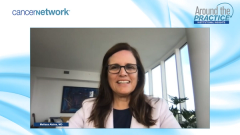
Multiple Myeloma: Unmet Needs and Future Perspectives
Closing out their discussion on the management of multiple myeloma, experts from the Moffit Cancer Center highlight key unmet needs and future directions in care.
Episodes in this series

Transcript:
Melissa Alsina, MD: That brings us to our final discussion. What is still an unmet need in myeloma? What other things do we need? And what are your future perspectives on the treatment of newly diagnosed and relapsed myeloma? Let’s start with Rachid.
Rachid Baz, MD: There are a lot of unmet needs for patients with myeloma. But what’s most important is that we need to generate data that look at patients who haven’t traditionally been enrolled on a trial. We need to be able to enroll on a trial patients who’ve traditionally been excluded from studies. I’d love to see patients who have renal failure permitted on some studies, or patients who had prostate cancer 2 years ago but they’re doing OK. They’re arbitrarily excluded from studies. This is the most important thing we can change. If we can have patients go on a study, the field can move faster. We’ll learn more and won’t end up with studies that we can’t generalize to patients we see in clinic. There are a lot of things that you guys are saying that I agree with wholeheartedly. But this is close to my heart. We do need to do better on this end.
Ken Shain, MD: I couldn’t agree more: we don’t study all the patients we need to treat. Studies are done to get therapies and drugs approved, not to see whom we should be treating with these drugs. We have to balance those things. I’m not going to steal that point because you said it eloquently. Everything in myeloma is an unmet medical need because we still don’t cure patients, so there’s no blanket statement. When I drill down to what the need is, we see even with these novel quad therapies—transplants, risk-adaptive therapies—we still see these a marked difference. We’re moving the needle forward, meaning PFS [progression-free survival] is better for everybody, but it’s disproportionate for standard-risk patients.
But high-risk patients are the folks we really need to figure out how we’re going to take care of. They still have half the PFS on whatever study you look at. We’re doing a lot better when you have quadruplet and triplet [drug combinations], but they’re still not there. They’re still not reaching the same time points. They’re still dying much earlier. Our definition of high risk isn’t really adequate. We’ve got to figure out what that means.
The MASTER trial brought up a great point. It talks about D-KRd [daratumumab, carfilzomib, lenalidomide, dexamethasone] inductions to reach MRD [minimal residual disease] negativity. Maybe 1 bad thing is OK, but 2 bad things are really bad because you still progress early. These highlight the fact that high-risk patients are something we haven’t addressed very well. Hopefully, as we translate immunotherapies further with deeper levels of response, we can start catching up. But we have to keep that in mind when we’re making our decisions: how we fix and help these individuals more than how we bring them back up to the standard-risk patients.
Brandon Blue, MD: The biggest unmet need that probably needs to be addressed as soon as possible, probably even yesterday, are the disparities happening in myeloma. We keep coming up with new therapies, but the disparity gap between Black patients and Hispanics isn’t closing. As we continue to come up with new treatments, I worry about that gap and the disparity of how patients were having inferior overall survival and worse outcomes may be widening that gap. Unfortunately, we have patients who aren’t even transplanted. What do we call health care utilization, meaning that transplant is here, and certain groups of people are taking advantage of transplant? We consider transplant to be part of the standard of care. There are groups of people who are eligible for it and could receive it, but they’re still not. Now we have CAR T available. How many people are going to do health care utilization? If it’s available to them, they should use it. It’s right there, but they’re still not utilizing it. That same story can be told over and over. That’s 1 thing we can focus on. If we have a group of patients who are having inferior outcomes, we have to make sure they’re getting some of the best treatments.
Melissa Alsina, MD: I don’t have a lot to say because you guys covered everything perfectly. The last point is that we need to cure myeloma. If we have a patient with myeloma who dies from that disease, we still have a lot of work to do. We’ve come a long way, but we still have a lot of work to do.
I want to thank the organizers for allowing us to do this. I want to say to the audience that we’re here at Moffit Cancer Center. We’re available, and you can reach out to us at any point if we can help you in any way take care of your patients with myeloma. I want to thank Rachid, Ken, and Brandon for this discussion. And to our audience, thank you very much for joining us. We hope you found this Cancer Network® Around the Practice® discussion to be useful and valuable for the treatment of your patients with myeloma.
Transcript edited for clarity.
Newsletter
Stay up to date on recent advances in the multidisciplinary approach to cancer.






















































































